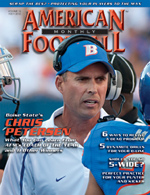Article CategoriesAFM Magazine
|
Fields of Dreamsby: AFM Editorial Staff© More from this issue AFM: What are the most significant reasons why so many football programs across the country have invested in synthetic turf fields in the last decade? Eric Daliere of FieldTurf: One major reason is player safety. The findings of a long-term testing program show that FieldTurf is equal to – if not better than – natural grass in most critical areas of player safety. An independent, three-year study of competitive college football showed that when compared to natural grass the FieldTurf system leads to 74% fewer muscle tears, 42% lower ACL trauma, 32% fewer ligament tears, 22% fewer severe injuries, 2% fewer concussions and 7% fewer total injuries. In addition to the benefits of synthetic turf you mentioned, are there other advantages that turf offers over natural grass? Daliere: In addition to well documented safety and performance benefits, there are many advantages to synthetic turf when compared to natural grass. Specifically, synthetic turf not only allows owners to save a significant amount of money on maintenance but it has proven to be a revenue generator, allowing for communal use and field rentals due to built-in durability characteristics. Dobmeier: Another advantage of synthetic grass over natural is the consistent safety. Using specialized infill allows for shock absorption that parallels natural grass – meaning less impact to the athlete. By adding an optional resilient ShockPad under the synthetic grass, the G-Max , which measures the surface’s shock absorption, is even greater, and remains like perfectly manicured natural grass for the life of the surface. From an economic standpoint, what are the major factors for schools to consider when evaluating the decision to switch to synthetic turf? Dobmeier: The most significant increase in value of synthetic over natural is the use. Every situation is unique, but generally speaking synthetic fields are used 10+ times as much as natural and maintain superior quality with a fraction of the maintenance. An athletic field is a major financial investment, in addition to a high-profile investment. The amount of interest in any new field is huge. Whether a project goes well or not is very much a function of the company behind the product components. Field building is specialized construction. My advice to schools is always the same. Do your research to protect your investment. Look at the stability of the company being considered, the warranty offered and talk to schools that have installed their fields. Ask if they are satisfied over time. Daliere: FieldTurf has installed thousands of fields in North America for schools at all levels. Based on the company’s extensive experience, the major factors for schools to be aware of when looking at upgrading to synthetic turf from their natural grass surface are the company’s financial stability and insured warranty, the significant maintenance savings, the increased potential for revenue generation, the significantly lower cost per hour of use and the lower number of injuries. |
|
| HOME |
MAGAZINE |
SUBSCRIBE | ONLINE COLUMNISTS | COACHING VIDEOS |
Copyright 2024, AmericanFootballMonthly.com
All Rights Reserved




